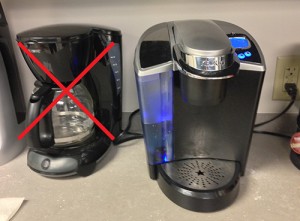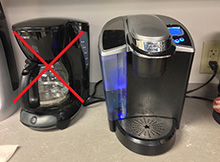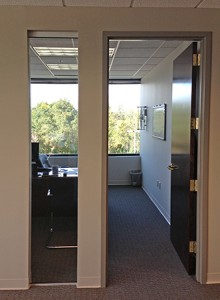Recently, we moved to new offices, and the opportunity to upgrade and enhance our equipment and office infrastructure presented itself. In going through this project, it was dramatic how much of an impact keeping energy in mind had while making simple business choices on our new total energy footprint.
Side-Lights in Offices
By adding a marginal cost increase to our office build-out for 18 inch wide glass panels next to all the office doors, light is more easily distributed through our office, particularly from the perimeter offices into the interior open workspaces. The net effect is the elimination of the need for lamps for lighting in the open work spaces and a reduction in lighting for the perimeter offices. On most days, I don’t even turn on my office lights since I have enough natural light from the sun that the florescent lamps would be a waste. This makes a real impact in overall power reductions.
Laptops vs. Desktops
A typical laptop these days consumes about 40W of power, and typical desktops are still typically around 125W. Flat panels that are LED lit instead of LCD with florescent tubes use 20W instead of 40W. With Active Directory policies, the laptops hibernate unless used outside of office hours, resulting in nearly zero usage unless someone is working late. Since working hours are 23.8% of total hours, each employee is now using 342 Watt-Hours of power per day instead of 942 Watt-Hours of power per day. That is 2.75 times more efficient, per employee, and with less noise.
Lobby
In our lobby and conference rooms, we needed some 50 inch displays to communicate market information and company-wide data to our staff and visitors. Picking low power LED lit LCD panels for displays in the lobby instead of Plasma resulted in 85W usage instead of 160W usage, with nominal cost difference.
Phones
Elimination of the phone PBX and using VOIP technology completely eliminates several hundred watts of continuous power, and has eliminated another device that required maintenance and generated heat in the server room.
The Break Room

Selecting to use a single serving coffee maker instead of traditional hot-plate coffee makers is a huge percentage savings. The single serving fires up the water for a high brewing cycle power draw of around 1,000W, but sits idle with near zero consumption. How long do you brew coffee a day? 15-20 minutes? But the hot plate sits there all day. Besides, the coffee tastes better for those of us addicted to Starbucks.
Conference Rooms
We installed LED lighting in the conference room. With this replacement the spot lights went from 60W each (720W total) to 17W each, or a total of 204W. These lights look great and don’t suffer from the slow warm up with CFLs.
Also, consider your projector. For conference rooms with no outside windows of course, or those that have blinds on the windows, you can easily reduce the overall ambient light. Why then put into the room a projector with more light than needed? The extra light means a lot more power required and heat generated. We found 1000 to 1100 lumens to be more than sufficient for these rooms even for 80 inch wide images.
Consider Paperless
Using online systems for data and breaking the habit of printing things that will only be filed makes more sense on many sustainability levels. Because we are almost entirely paperless, we have only three printers. In most offices, there would be more and larger devices to handle the workload. Using heavy-duty workgroup ink-jets instead of laser engines, and setting the one laser engine we have to low power when idle, has reduced noise, reduced power draw, and kept from putting unwanted heat in the office.
With the reduction in paper, you reduce printer/copier consumables.You reduce expenses of filing and storage of paper documents. You reduce the square footage necessary for the office since there is no paper storage. And the amount of time to retrieve or find the document, if properly indexed, is a fraction of the employee time to find something on paper.
Totaling up the Savings
Don’t forget that every watt you trim from plug loads translates into a direct savings in HVAC as well. When heat is generated, the A/C system has to remove that heat from the building.So a reduction on the plug load actually has a compounding effect on overall total savings.
When we totaled up our plug load savings, we concluded that we are operating at less than half the energy per employee than we did in our previous office location! We have effectively doubled in size with no increase to our carbon footprint. This is all achieved by simply keeping energy in mind when making choices for equipment and not picking the “standard” devices as typically done by an office manager or the IT department.

